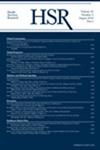Comparing imputation approaches for immigration status in ED visits: Implications for using electronic medical records
Abstract
Objective
This study aimed to compare imputation approaches to identify the likely undocumented patient population in electronic health record (EHRs). EHR are a promising source of information on undocumented immigrants' medical needs and care utilization, but there is no verified way to identify immigration status in the data. Different approaches to approximating immigration status in EHR introduce unique biases, which in turn has major implications on our understanding of undocumented immigrant patients.
Study setting and design
We used a dataset of all emergency department (ED) visits from 2016 to 2019 in the Los Angeles Department of Health Services (LADHS) merged across patient medical records, demographic data, and claims data. We included all ED visits from our patient groups of interest and limited to patients at or over the age of 18 years at the time of their ED visit and excluded empty encounter records (n = 1,106,086 ED encounters).
Data sources and analytic sample
We created three patient groups: (1) US-born, (2) foreign-born documented, and (3) undocumented using two different imputation approaches: a logical approach versus statistical assignment. We compared predicted probabilities for two outcomes: an ED visit related to a behavioral health (BH) disorder and inpatient admission/transfer to another facility.
Principal findings
Both approaches provide comparable estimates among the three patient groups for ED encounters for a BH disorder and inpatient admission/transfer to another facility. Undocumented immigrants are less likely to have a BH diagnosis in the ED and are less likely to be admitted or transferred compared to the US-born.
Conclusions
Researchers should consider expanding EHR with administrative data when studying the undocumented patient population and may prefer a logical approach to estimate immigration status. Researchers who rely on payer status alone (i.e., restricted Medicaid) as a proxy for undocumented immigrants in EHR should consider how this may bias their results. As Medicaid expands for undocumented immigrants, statistical assignment may become the preferred method.


 求助内容:
求助内容: 应助结果提醒方式:
应助结果提醒方式:


